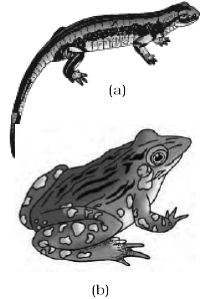Class Amphibia name indicates (Gr. Amphi : dual, bios, life), amphibians can live in aquatic as well as terrestrial habitats (Figure). Most of them have two pairs of limbs. Body is divisible into head and trunk. Tail may be present in some. The amphibian skin is moist (without scales). The eyes have eyelids.

Fig: Salamandra, Frog
A tympanum represents the ear, Alimentary canal, urinary and reproductive tracts open into a common chamber called cloaca which opens to the exterior. Respiration is by gills, lungs and through skin. The heart is three-chambered (two auricles and one ventricle). These are cold-blooded animals. Sexes are separate. Fertilisation is external. They are oviparous and development is direct or indirect.
Examples: Bufo (Toad), Rana (Frog), Hyla (Tree frog), Salamandra (Salamander), Ichthyophis (Limbless amphibia).












